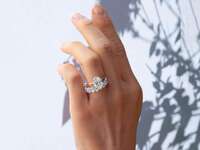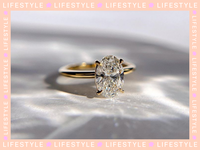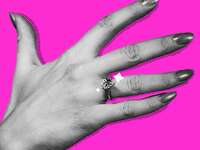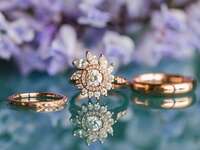The Ultimate Guide to the 4 Cs of Diamonds (And Why They Matter)
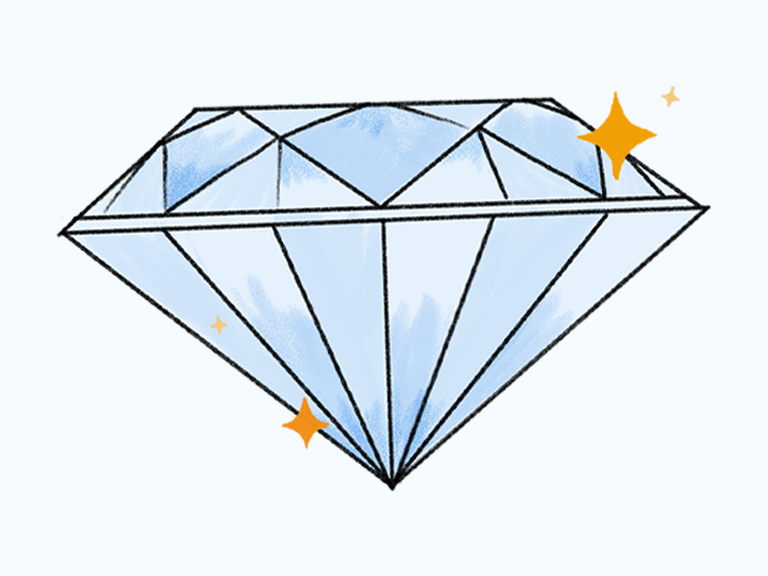
When you begin shopping for an engagement ring, you'll quickly discover endless information about the different types of diamonds, shapes, metals, settings, and much more. As you dive deeper into the process of buying a diamond, you'll eventually be met with the 4 Cs. Most, if not all, shopping guides and jewelry websites include information about the 4 Cs of diamonds. If you're particularly new to gemstone sourcing, you might be wondering what they are, and if they really impact your final selection. (Spoiler alert: they do!)
While the 4 Cs definitely are important, don't stress about becoming an expert just because you're in the market for an engagement ring. While it's helpful to know the background of the 4 Cs before you shop, any jeweler or ring designer should be able to guide you through the process. "You can—and should—ask your jeweler questions about the 4 Cs," says Boston-based jeweler Hannah Florman. "While you should do some research beforehand, your jeweler is an expert. These characteristics are only meant to be a guiding tool to make sure that you get a quality ring."
Below, we explain the 4 Cs of diamonds to help you feel confident in your engagement ring shopping experience. As soon as you're ready to take the next step, check out The Knot Vendor Marketplace to locate a reputable jeweler near you and begin shopping for the perfect proposal piece.
- The 4 Cs of diamonds are cut, color, clarity and carat.
- The 4 Cs were developed by the Gemological Institute of America (GIA) as a way to standardize diamond grading.
- The 4 Cs are used to determine a diamond's value and its cost.
In this article:
What is Diamond Grading?
The 4 Cs of diamonds are cut, color, clarity and carat. Easy enough, right? But understanding what each C stands for (and how it impacts your diamond purchase) is a bit more nuanced. "The 4 Cs are the standards by which all diamonds are evaluated, and they play a role in determining a diamond's value and beauty," explains De Beers Diamond Expert Kristen Lawler-Trustey. All diamonds are evaluated using a standard grading scale developed in the 1940s by the Gemological Institute of America (GIA). A diamond's cut, color, clarity and carat are used to complete a grading report, which determines its quality and price.
When you go engagement ring shopping, any jeweler or showroom associate can pull specific diamond options that fit your vision (and your budget). "Retailers use the 4 Cs to educate shoppers, helping them balance their preferences and budget to find the right diamond," says KAY Jewelers VP of Merchandising Lisa Ingram. "Some prioritize carat weight, while others focus on clarity or color. Understanding the 4 Cs empowers consumers to make informed purchases that align with their personal priorities."
And, because we know you're wondering, there's no such thing as a 4 C hierarchy. (Read: If you're Googling "diamond 4 C's in order of importance," know that the information you find may be conflicting.) "There isn't one 'C' that is more important than the others," says Akshie Jhaveri, founder of Grown Brilliance. "It all comes down to personal preference. Each shopper values different aspects of a diamond based on what matters most to them."
Understanding the 4 Cs of Diamonds
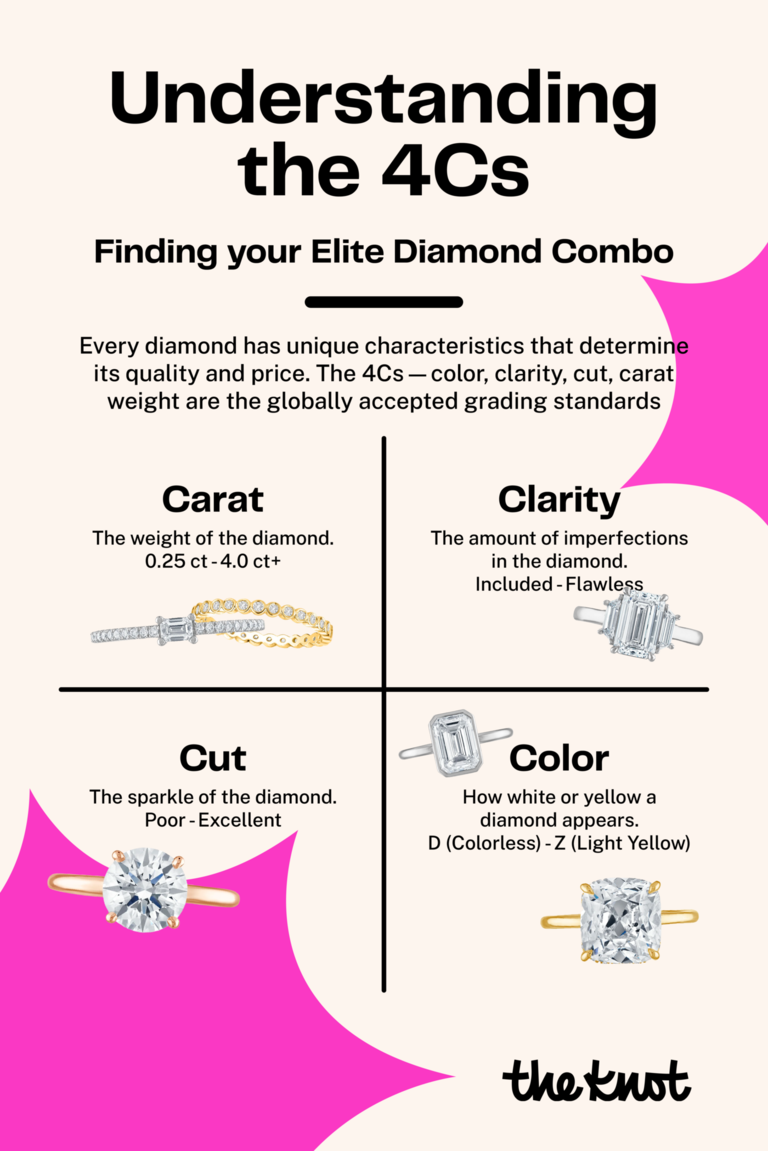
The 4 Cs apply to both mined and lab-grown diamonds. Whether you're engagement ring shopping online or in-person, it's important to ensure your diamond of choice has a legitimate grading that identifies each 4 C characteristic. (Psst: Not only is that essential to ensure you're buying a legitimate diamond, you'll need that information if you want to insure your ring or get a ring appraisal.) Below, we define what the diamond 4 Cs mean, and why they all play a role in your purchase.
Diamond Cut
While it's true that all 4 Cs are equally important, a diamond's cut may slightly edge out the rest. "Cut determines how well the diamond reflects light, impacting its brilliance and overall appeal," says Jhaveri. While you might assume that a diamond's cut is related to its physical shape, this C actually refers to its internal faceting. "A diamond's cut is what gives it that signature sparkle," Jhaveri continues. "A well-cut diamond reflects light beautifully, making it brilliant and eye-catching, while a poorly cut one can look dull, even with great color or clarity."
According to Jhaveri, there are six cuts that categorize a diamond:
- Ideal Cut: Perfect symmetry and proportions for maximum sparkle.
- Excellent Cut: Incredible brilliance with precise faceting.
- Very Good Cut: Great sparkle with good symmetry and polish.
- Good Cut: Decent shine with reasonable symmetry.
- Fair Cut: Noticeably less sparkle and symmetry.
- Poor Cut: Dull, uneven, and lacks brilliance
Although most of us can't detect subtle differences in carat weight or clarity, Jhaveri warns that a diamond with a poor cut can be spotted by anyone—not just jewelers or gemologists: "Even an untrained eye can see the difference, as higher cut grades create more sparkle and a more stunning diamond."
Diamond Color
Next on the list of 4 Cs is color. You might assume that all diamonds have no tint, but they're actually graded on a scale of colorlessness. "Diamonds range in color from D (completely colorless) to Z (light yellow or brown)," says Ingram. Colorless diamonds are the most valuable, which means they come with a higher price tag.
One way to make the most out of your engagement ring budget is to have your jeweler pull center stone options that appear colorless to the naked eye, even if they are graded lower on the scale. "At KAY Jewelers, we've worked to find the right balance of quality and inclusive price ranges, so most of our diamonds fall in the 'near colorless' range (G-J), which means they look bright and beautiful without the premium price tag of a completely colorless stone," Ingram explains. "But it's really about personal preference. Colored diamonds, like pink, blue, and yellow, are also incredibly special and sought after."
Diamond Clarity
Clarity is the next diamond 4 C, and this characteristic measures imperfections within the stone. "Every diamond gets graded based on its clarity, which is all about how many imperfections (or inclusions) it has and how visible they are," Jhaveri says. "To figure this out, gemologists examine the diamond under 10X magnification, checking the size, number, and placement of these tiny flaws." She notes that the standard clarity scale ranges from Flawless (FL) to Included (I3), as detailed below:
- Flawless (FL): No imperfections inside or on the surface—rare and valuable.
- Internally Flawless (IF): No visible inclusions, even under magnification, though there might be tiny ones only an expert could spot.
- Very Very Slightly Included (VVS1 & VVS2): Nearly perfect to the naked eye, with only tiny inclusions visible under magnification.
- Very Slightly Included (VS1 & VS2): Minor inclusions that might be visible with close inspection.
- Slightly Included (SI1, SI2, SI3): Small inclusions that can be seen even without magnification.
- Included (I1, I2, I3): Noticeable imperfections, easily seen without any magnification.
While this information is important, it's highly unlikely that the average person will walk into a jewelry store and ask for a VVS1 diamond engagement ring. Instead, you may hear your gemologist recommend a center stone that's "eye-clean," which is a much easier way to understand this diamond 4 C. "The diamonds most buyers go for are called 'eye-clean,' meaning there are no visible inclusions unless you use a magnifying glass," Jhaveri says. "Typically, a VS1 rating or higher is considered eye-clean."
Diamond Carat
Last, but certainly not least, is carat. Contrary to popular belief, engagement ring carat size does not signify how "big" your sparkler is. "Carat denotes weight, instead of size, and is measured in increments called points," says Ingram. "One carat equals 100 points, which weighs .20 grams." Compared to the other diamond 4 Cs, Jhaveri adds that this descriptor is the most straightforward: "It's purely about weight, unlike cut, color, or clarity, which are more subjective."
When it comes to choosing a diamond, being flexible with its carat weight is an easy way to maximize your budget. While a 3-carat engagement ring will have a significant price tag, opting for a similar stone that's a few carats less can help minimize the cost without drastically changing the overall appearance. This emphasizes the importance of working with a jeweler, as the nuances between stones are best explained by experts. "Although carat is commonly associated with value, two diamonds with the same carat weight can look totally different depending on their cut, color, and clarity," Ingram says.
Who's Who of Diamond Grading
Now that you know what they are, you might be wondering who created the 4 C's of diamonds and why. The concept of the 4 C's was established in the 1940s by Robert M. Shipley, the founder of the GIA. Before this diamond terminology was widely accepted, experts used different words to classify diamonds, which led to confusion and inconsistencies.
To help his students better understand diamond grading, Shipley created the 4 Cs as a mnemonic device. The concept stuck, and eventually achieved mainstream notoriety. Now that they're more widely understood, the 4 Cs have also helped jewelers communicate the elements of a diamond engagement ring to customers (like you!).
While almost all diamonds receive a GIA grading, you may come across a stone with an IGI report. Like the GIA, the International Gemological Institute (IGI) is one of the largest independent grading and accreditation service providers in the world. The IGI also uses the 4 Cs to provide grading and accreditation for loose diamonds and gemstones.

